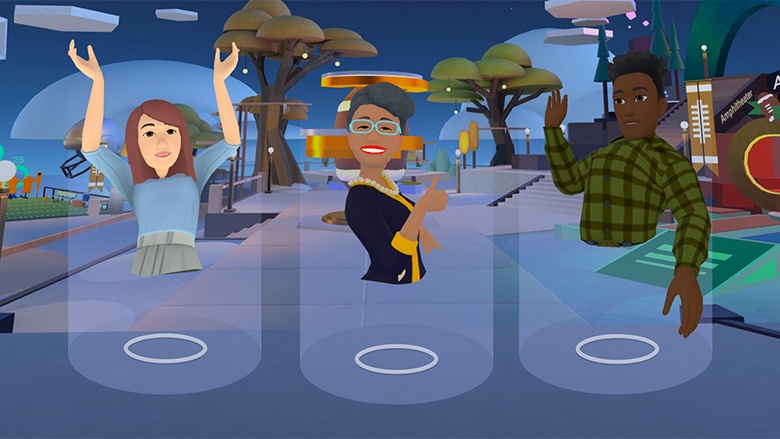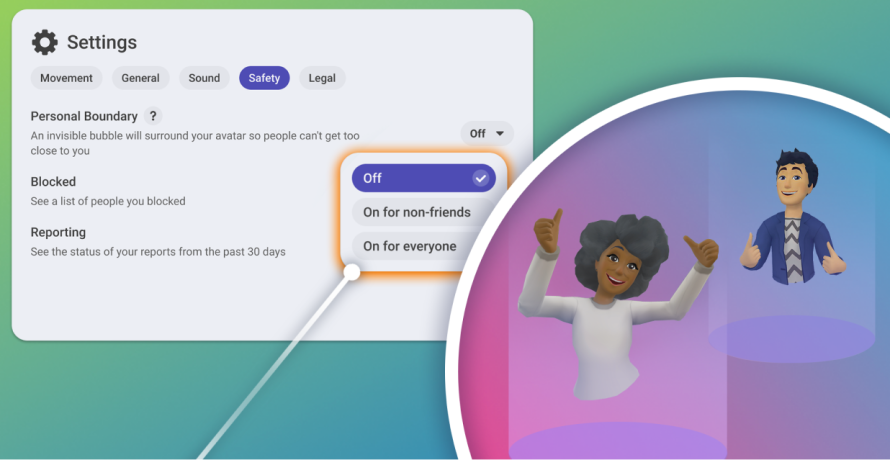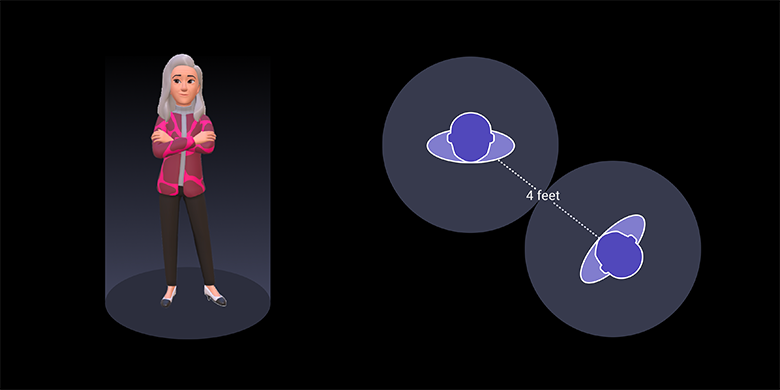Update on December 13, 2023 at 10:00AM PT:
Last year, we introduced personal boundary to prevent avatars from coming too close and to limit unwanted interactions. Since then, we’ve heard feedback from the community on how people use personal boundary to enhance their experience. We’ve made updates to personal boundary so avatars will now fade faster, increasing the feeling of comfort and control within your personal boundary. We’ve also made adjustments to the physical barrier while still maintaining roughly a few feet of distance, so you can now more easily participate in positive social gestures like high fives.
Update on March 15, 2022 at 8:15AM PT:
Today, we’re announcing an update to our recently launched Personal Boundary for Horizon Worlds that will give people more control over their experience. Personal boundary is an invisible boundary that creates more space between people so others can’t come too close and to make it easier to avoid unwanted interactions. Personal Boundary will remain on by default for non-followers, and now you’ll be able to adjust your Personal Boundary from the Settings menu in Horizon Worlds.
Based on community feedback, you can now choose from three options that give our community more customized controls so they can decide how they want to interact in their experiences:
- On for People You Don’t Know: The default on setting—your Personal Boundary is set to a roughly a few feet distance between your avatar and people you don’t follow back
- On for Everyone: Your Personal Boundary is set to a roughly a few feet distance between your avatar and any other avatars
- Off: Your Personal Boundary is off between your avatar and others
These new options should make it easier to high-five, fist-bump, and take selfies with other avatars while in Horizon Worlds. And when two people meet, Personal Boundary will default to the more restrictive setting (for example, if your Personal Boundary is Off but the avatar you’re interacting with has Personal Boundary set to On for Everyone, there will be a roughly few feet distance between you). In Horizon Venues, Personal Boundary will be default on at a roughly few feet distance for everyone.
Developing for VR presents what are perhaps some of the hardest challenges we’ve tackled in a generation of computing now that we’re no longer limited by fixed viewpoints and traditional flatscreen devices. By preventing avatars from coming within a set distance of each other, Personal Boundary creates more personal space for people and makes it easier to avoid unwanted interactions. We’ll continue to iterate and make improvements as we learn more about how Personal Boundary impacts people’s experiences in VR.
Originally published on February 4, 2022 at 10:10AM PT:
Today, we’re announcing Personal Boundary for Horizon Worlds and Horizon Venues. Personal Boundary prevents avatars from coming within a set distance of each other, creating more personal space for people and making it easier to avoid unwanted interactions. Personal Boundary will begin rolling out today everywhere inside of Horizon Worlds and Horizon Venues, and will by default make it feel like there is an almost 4-foot distance between your avatar and others. Over time, we’ll continue to make improvements as we learn how this affects people’s experiences.
How It Works
A Personal Boundary prevents anyone from invading your avatar’s personal space. If someone tries to enter your Personal Boundary, the system will halt their forward movement as they reach the boundary. You won’t feel it — there is no haptic feedback. This builds upon our existing hand harassment measures that were already in place, where an avatar’s hands would disappear if they encroached upon someone’s personal space.
Setting New Norms for Social VR
We are intentionally rolling out Personal Boundary as always on, by default, because we think this will help to set behavioral norms — and that’s important for a relatively new medium like VR. In the future, we’ll explore the possibility of adding in new controls and UI changes, like letting people customize the size of their Personal Boundary.
Note that because Personal Boundary is the default experience, you’ll need to extend your arms to be able to high-five or fist bump other people’s avatars in Horizon Worlds or in Horizon Venues.
The Road Ahead
Virtual reality can and should be for everyone. And we’re constantly working to improve people’s experience in VR, gathering feedback from the community to inform our work as we continue to iterate and make improvements.
We believe Personal Boundary is a powerful example of how VR has the potential to help people interact comfortably. It’s an important step, and there’s still much more work to be done. We’ll continue to test and explore new ways to help people feel comfortable in VR.


